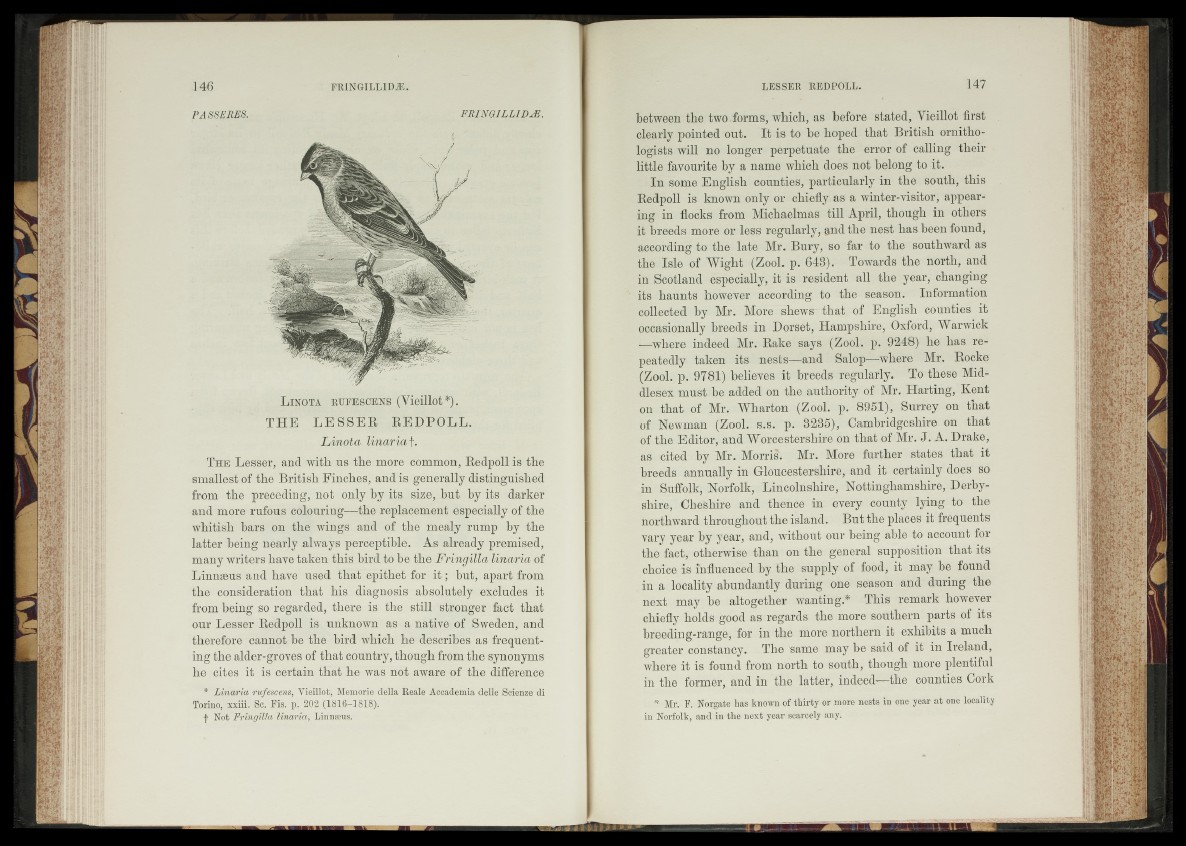
L in o ta r t jfe sc en s (Vieillot*).
THE L E S S E R R EDPOLL.
Linota linaria
T h e Lesser, and with ns the more common, Redpoll is the
smallest of the British Finches, and is generally distinguished
from the preceding, not only by its size, hut by its darker
and more rufous colouring—the replacement especially of the
whitish bars on the wings and of the mealy rump by the
latter being nearly always perceptible. As already premised,
many writers have taken this bird to be the Fringilla linaria of
Linnaeus and have used that epithet for i t ; hut, apart from
the consideration that his diagnosis absolutely excludes it
from being so regarded, there is the still stronger fact that
our Lesser Redpoll is unknown as a native of Sweden, and
therefore cannot he the bird which he describes as frequenting
the alder-groves of that country, though from the synonyms
he cites it is certain that he was not aware of the difference
* Linaria rufescens, Vieillot, Memorie della Reale Accademia delle Seienze di
Torino, xxiii. Sc. Fis. p. 202 (1816-1818).
j- Not Fringilla linaria, Linnaeus.
between the two .forms, which, as before stated, Vieillot first
clearly pointed out. It is to he hoped that British ornithologists
will no longer perpetuate the error of calling their
little favourite by a name which does not belong to it.
In some English counties, particularly in the south, this
Redpoll is known only or chiefly as a winter-visitor, appearing
in flocks from Michaelmas till April, though in others
it breeds more or less regularly, and the nest has been found,
according to the late Mr. Bury, so far to the southward as
the Isle of Wight (Zool. p. 648). Towards the north, and
in Scotland especially, it is resident all the year, changing
its haunts however according to the season. Information
collected by Mr. More shews- that of English counties it
occasionally breeds in Dorset, Hampshire, Oxford, Warwick
—where indeed Mr. Rake says (Zool. p. 9248) he has repeatedly
taken its nests—and Salop—where Mr. Rocke
(Zool. p. 9781) believes it breeds regularly. To these Middlesex
must be added on the authority of Mr. Harting, Kent
on that of Mr. Wharton (Zool. p. 8951), Surrey on that
of Newman (Zool. s.s. p. 3285), Cambridgeshire on that
of the Editor, and Worcestershire on that of Mr. J . A. Drake,
as cited by Mr. Morris. Mr. More further states that it
breeds annually in Gloucestershire, and it certainly does so
in Suffolk, Norfolk, Lincolnshire, Nottinghamshire, Derbyshire,
Cheshire and thence in every county lying to the
northward throughout the island. But the places it frequents
vary year by year, and, without our being able to account for
the fact, otherwise than on the general supposition that its
choice is influenced by the supply of food, it may be found
in a locality abundantly during one season and during the
next may be altogether wanting.* This remark however
chiefly holds good as regards the more southern parts of its
breeding-range, for in the more northern it exhibits a much
greater constancy. The same may be said of it in Ireland,
where it is found from north to south, though more plentiful
in the former, and in the latter, indeed—the counties Cork
* Mr. F. Norgate has known of thirty or more nests in one year at one locality
in Norfolk, and in the next year scarcely any.